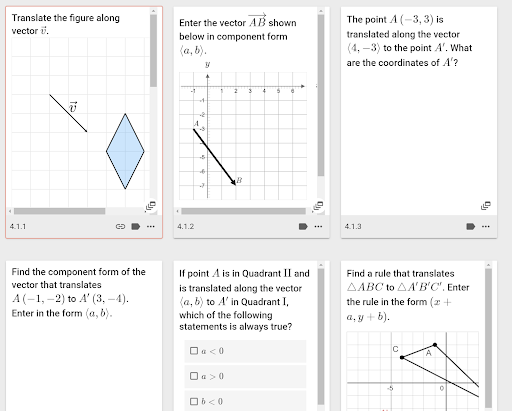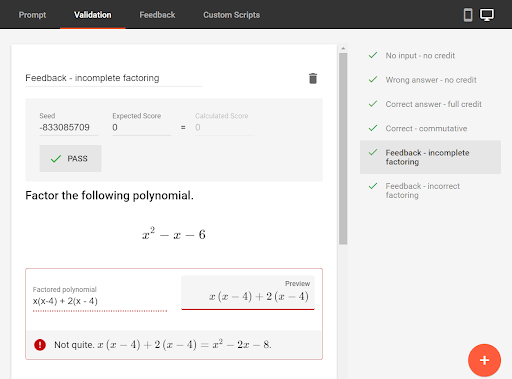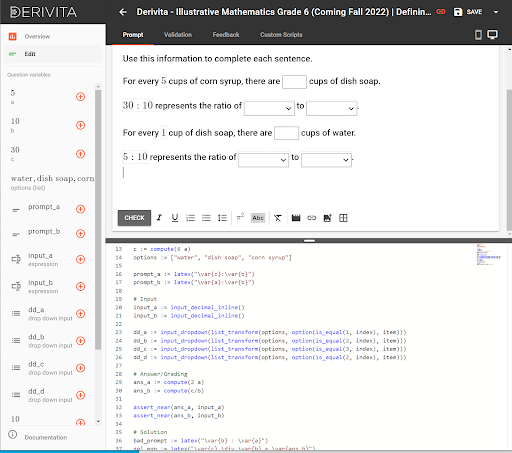Deep Dive Into The World of Content Building

Derivita’s Content Team, led by Christine Lien, has created a math test bank of over 50,000 test items with 10-100’s variations for each test item accessible for all educators within the Derivita platform.
This is no small feat. But how is this test bank created? In this blog, Christine walks us through the steps her team takes to ensure that the Derivita content library is accurate, flexible, and full of options to meet the needs of various educators and students.
Step 1: Asking the right questions
The Derivita Specifiers start off the content-creating process by first deciding what a Derivita educator may be attempting to assess with a singular test item.
The first question Specifiers ask is “What is the goal of the question?”. Christine articulates, “Then they’ll take that goal and write a question that test the specific, requisite skills and really hone in and focus on those skills to achieve mastery”. This process also dictates how the randomized versions of the questions are made.
Step 2: Creating randomizations
The same skill needs to be tested at a similar level of difficulty, but with different values to give educators options when they are building a Derivita assignment or exam. Some questions have pretty strict limitations or need to be based in reality and therefore only allow five or so variations, when other questions have no limitations and can have thousands of variations.
Step 3: Solution presentation
Crafting the solutions to the questions also falls to the Specifiers. They “write out how the solution is going to be presented that is specific for the grade level of that particular assessment item”. In general, Christine’s team tries to keep their worked-out solutions concise for clarity and to match the average students’ attention spans for assessment solutions.
This forces the solutions to hit on the main points students need to know to move forward and ensure their success next time they see a similar problem. “We don’t see this [worked-out solutions] as where we can teach you all about the Law of Sines…it's more this is the Law of Sines and this is how you use it”, Christine adds.
Step 4: Developing immediate and meaningful feedback
Our automated nudges and feedback target individual mistakes our Specifiers have seen before and can anticipate, making Derivita feedback more helpful and human for the student.
Christine says, “Our Specifiers have years of teaching experience and they draw on their teaching knowledge to decide on what the right feedback is for a student or what are common misconceptions for a question of this type or what misconceptions come with this skill and then they write [student] targeted feedback”.

Step 5: Bring in the implementers
The created “specification document” complete with the single question, randomizations, solutions, and feedback goes to our Implementers. Christine describes Derivita Implementers as “what I call ‘our experts in Omaha [our autoring platform]’ - they really know how to best code that question type [into the Derivita system]”.
As an extra layer of quality control, all of our Implementers have a math background and can offer the Specifiers feedback on how to better word or format parts of specification document and the individual test item.
Step 6: Review, review, review
After the test items have been coded into the system, the math test items go through a review process. This is where any and all members of the content team participate in trying to “break the question”.
Christine says that her team “will pretend to be that really clever, creative student who will try to test the boundaries of answer acceptance”. They also look for basic errors like typos as well as make sure the code is up to standard with proper formatting. Then it goes back to the Implementers to make the required edits.
Step 7: Ready to test
After the edits are made it goes to our Math Testers who are actual students! Currently, Derivita has “two college students [with Math majors] and two high school students, who basically just do math homework” on staff. These testers never see the back-end of the Derivita content library and are set up with these assignments within a Canvas instance.
These students offer feedback on instruction wording, feedback, clarity of questions and solutions, the visualization on a desktop computer or a mobile device, or even the mathematics of the actual question. The requested edits then go back to Specifiers and Implementers to ensure the wording and formatting need to be updated and are just right.
Step 8: We’re live from Derivita!
Once the changes and edits have been made by the Implementer and the Specifier, who wrote the original specification document and question item, does a final review- it's time for publication. Once the test item is published to the content library, it and its randomizations are immediately available for all Derivita users.

3 Commonly-asked Questions
1. How long does this content-creating process take?
This 8-step process typically takes about two weeks (14 days) to complete from start to finish.
2. How is this content-creating process initiated?
The process is started and completed based on feedback, interests, and needs of our current client base.
3. What math content is Derivita building now?
At the moment, Christine and her team are building Grade 6-8 middle school mathematics content as well as a more robust Geometry test bank.
Ready to access the Derivita math content library?
